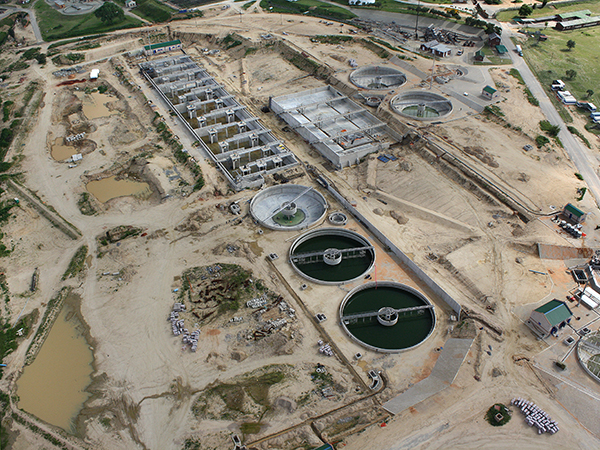
Northern Wastewater Treatment Works
Cliente
Johannesburg WaterUbicación
Gauteng, South AfricaAspectos destacados
- Full process for a 50 Mℓ/day treatment works
- Inclusive of bulk earth works, civil structures, and mechanical and electrical equipment
- New head of works and upgrading of existing
- All building for housing of equipment

Construction of Module 2 of Unit 5 – Phase II
Project Overview
The Northern Wastewater Treatment Works (WWTW) is located on the Jukskei River, some 30 km north of the Johannesburg CBD and serves most of the city of Johannesburg’s sewer basins north of the Witwatersrand, the continental divide. The Northern WWTW is the largest of six wastewater treatment works situated in the city of Johannesburg, South Africa. Designed to treat 400 million litres of wastewater every day for approximately 1.6 million people.
The site has been operating as a WWTW for over 50 years, initially with a single treatment unit. The capacity of the WWTW has been increased by adding units, the latest of which was the first phase (Module 1) of Unit 5, commissioned in 2009.
Project Role
The KW Joint Venture (KWJV), a joint venture between Knight Piésold and WSP Group Africa, has been appointed by Johannesburg Water (JW) under contract “JW 13004: Procurement of Professional Services: Civil, Structural, Electrical and Mechanical Engineering Services (Bulk Wastewater).”
Knight Piésold was responsible for project management; civil, structural, mechanical, and electrical design; tender documents and procurement; and construction supervision and commissioning.
Investigation of:
- The penstock into the existing inlet channel as there have been indications that flow is being throttled at this point
- The 6.6 kV electrical reticulation system to ensure adequate power supply
- The possible use of Unit 3 waste activated sludge thickeners spare capacity for the Unit 5 stream
Preliminary design of:
- Module 2 civil infrastructure, including interconnecting pipework. Module 2 will be identical to Module 1, being composed of:
- Two primary sedimentation tanks (PSTs)
- A balancing tank
- A biological reactor
- Three secondary clarifiers
- An elutriation thickener
- A waste activated sludge (WAS) thickener
- A disinfection module consisting of a contact tank, storage, and dosing
- Additional HOW civil infrastructure and rationalization of all HOW civil infrastructure
- Ancillary civil infrastructure and mechanical, electrical, and control and instrumentation equipment